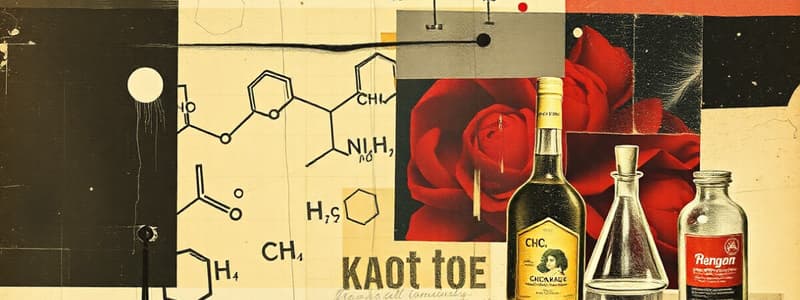Podcast
Questions and Answers
How do elements and compounds relate to matter?
How do elements and compounds relate to matter?
- Compounds are the building blocks of elements, which in turn make up matter.
- Matter is composed of elements, and elements can combine to form compounds. (correct)
- Elements, compounds, and matter are all interchangeable terms.
- Elements and compounds are forms of energy, while matter is a substance.
Which set of elements constitutes approximately 99% of the human body's mass?
Which set of elements constitutes approximately 99% of the human body's mass?
- Oxygen, carbon, hydrogen, nitrogen, calcium, phosphorus (correct)
- Calcium, sodium, potassium, hydrogen, oxygen, nitrogen
- Sodium, potassium, chlorine, magnesium, iron, zinc
- Carbon, hydrogen, oxygen, nitrogen, sulfur, iron
Which of the following is an example of a trace element's role in the human body?
Which of the following is an example of a trace element's role in the human body?
- Calcium's role in bone structure
- Carbon's function as a component of proteins
- Iron's role in oxygen transport and energy processing (correct)
- Phosphorus's purpose in teeth formation
What distinguishes the atoms of different elements from one another?
What distinguishes the atoms of different elements from one another?
What primarily determines whether an isotope is stable or radioactive?
What primarily determines whether an isotope is stable or radioactive?
How do atoms achieve stability through the formation of chemical bonds?
How do atoms achieve stability through the formation of chemical bonds?
What is the fundamental difference in electron interaction between ionic and covalent bonds?
What is the fundamental difference in electron interaction between ionic and covalent bonds?
What determines the type of covalent bond (polar or nonpolar) that forms between two atoms?
What determines the type of covalent bond (polar or nonpolar) that forms between two atoms?
How does an atom become an ion, and what determines the charge of the ion?
How does an atom become an ion, and what determines the charge of the ion?
How do polar covalent bonds in water molecules contribute to hydrogen bond formation?
How do polar covalent bonds in water molecules contribute to hydrogen bond formation?
Why is water known for its high boiling point compared to other liquids?
Why is water known for its high boiling point compared to other liquids?
Water absorbs lots of energy for which of the following reasons?
Water absorbs lots of energy for which of the following reasons?
How does evaporative cooling regulate temperature?
How does evaporative cooling regulate temperature?
Unlike most substances, ice floats on liquid water. Why?
Unlike most substances, ice floats on liquid water. Why?
In a solution, how does the role of the solute differ from that of the solvent?
In a solution, how does the role of the solute differ from that of the solvent?
How does water's polarity contribute to its effectiveness as a solvent?
How does water's polarity contribute to its effectiveness as a solvent?
What determines whether a substance is classified as an acid or a base?
What determines whether a substance is classified as an acid or a base?
Which best describes the arrangement of the pH scale?
Which best describes the arrangement of the pH scale?
How is pH value calculated?
How is pH value calculated?
How do buffers help maintain a constant pH in biological fluids?
How do buffers help maintain a constant pH in biological fluids?
Flashcards
What is matter?
What is matter?
Anything that occupies space and has mass.
What is an element?
What is an element?
A substance that cannot be broken down by ordinary chemical means.
What is a compound?
What is a compound?
Two or more different elements combined in a fixed ratio.
Main elements essential for life?
Main elements essential for life?
Signup and view all the flashcards
What are trace elements?
What are trace elements?
Signup and view all the flashcards
What is an atom?
What is an atom?
Signup and view all the flashcards
What is mass number?
What is mass number?
Signup and view all the flashcards
What are isotopes?
What are isotopes?
Signup and view all the flashcards
What are ionic bonds?
What are ionic bonds?
Signup and view all the flashcards
What are covalent bonds?
What are covalent bonds?
Signup and view all the flashcards
What is electronegativity?
What is electronegativity?
Signup and view all the flashcards
What are polar covalent bonds?
What are polar covalent bonds?
Signup and view all the flashcards
What is an ion?
What is an ion?
Signup and view all the flashcards
What is adhesion?
What is adhesion?
Signup and view all the flashcards
What is cohesion?
What is cohesion?
Signup and view all the flashcards
Why does water heat slowly?
Why does water heat slowly?
Signup and view all the flashcards
What is surface tension?
What is surface tension?
Signup and view all the flashcards
What is evaporative cooling?
What is evaporative cooling?
Signup and view all the flashcards
What is a solute?
What is a solute?
Signup and view all the flashcards
What is a solvent?
What is a solvent?
Signup and view all the flashcards
Study Notes
Matter, Elements, and Compounds
- Matter is anything that occupies space and has mass and can be found in solid, liquid, or gas form
- Elements are substances that cannot be broken down further by chemical means
- There are 92 naturally occurring elements like gold, copper, carbon and oxygen
- Compounds contain two or more elements in a fixed ratio, such as table salt (NaCl), made of sodium (Na) and chlorine (Cl)
Essential Elements for Life
- Six elements make up about 99% of the human body: oxygen, carbon, hydrogen, nitrogen, calcium, and phosphorus
- The first four are key components of proteins, carbohydrates, and lipids
- Calcium and phosphorus are major components of bones and teeth
Trace Elements
- Trace elements make up less than 0.01% of human body weight
- Trace elements include boron, chromium, cobalt, copper, fluorine, iodine, iron, manganese, molybdenum, selenium, silicon, tin, vanadium, and zinc
- Iron (Fe) is essential for oxygen transport in blood as part of hemoglobin
- Zinc (Zn) is important for enzyme function, immune system health, and DNA synthesis
- Iodine (I) is required to produce thyroid hormones that regulate metabolism
- Copper (Cu) plays a role in energy production and the formation of connective tissues
- Selenium (Se) acts as an antioxidant to protect cells from damage
- Manganese (Mn) is involved in bone formation and enzyme activation
Atomic Structure
- An atom, derived from the Greek word for "indivisible," is the smallest unit retaining element properties
- The nucleus contains protons (positive charge) and neutrons (neutral charge)
- Electrons are negatively charged subatomic particles
- Neutrons are electrically neutral
Atomic Number vs. Atomic Mass
- The atomic number defines an element by its unique number of protons; helium has an atomic number of 2 because it has 2 protons
- Atoms typically have an equal number of protons and electrons, resulting in a neutral charge
- The mass number is the sum of protons and neutrons; helium's mass number is 4
- Atomic mass is approximately equal to the mass number, measured in daltons
Stable vs. Radioactive Isotopes
- Isotopes are variations of an element with the same atomic number but different neutron numbers
- Carbon has three isotopes: carbon-12 (6 neutrons), carbon-13 (7 neutrons), and carbon-14 (8 neutrons)
- Carbon-12 is the most common isotope, making up about 99% of naturally occurring carbon
- Stable isotopes, like carbon-12 and carbon-13, have nuclei that remain intact
- Radioactive isotopes, like carbon-14, decay spontaneously, emitting particles and energy -Radiation from radioactive isotopes can damage cellular molecules and pose risks to living organisms
- Carbon-14 is used in dating fossils and is employed in biological research and medicine
- Stable isotopes have a balanced ratio of protons to neutrons allowing the strong nuclear force to counteract forces
- Radioactive isotopes have an imbalance, making the nucleus unstable
Electron Shells and Chemical Bonds
- Electron shells are regions around the nucleus where electrons are likely to be found, organized into energy levels
- The innermost shell has the lowest energy, and the outermost (valence) shell has the highest energy
- Each shell holds a maximum number of electrons: 2 in the first shell, 8 in the second shell, and so on
- Atoms seek stability by filling their valence shell, leading them to gain, lose, or share electrons through chemical bonds
Ionic vs. Covalent Bonds
Ionic Bonds
- Electrons are transferred, creating charged ions (positive and negative)
- These bonds are strong due to electrostatic attraction but can weaken in water
- An example is sodium chloride (NaCl), where sodium gives up an electron to chlorine
- Ionic bonds typically form crystalline solids that dissolve in water and conduct electricity
Covalent Bonds
- Atoms share pairs of electrons to fill their valence shells
- These bonds are generally stronger than ionic bonds
- Water (H₂O) is an example, where oxygen shares electrons with two hydrogens
- Covalent bonds usually form molecules with variable solubility that often do not conduct electricity
Key Differences
- Ionic bonds transfer electrons and form lattice structures
- Covalent bonds share electrons and form discrete molecules
- Ionic compounds are hard and brittle, while covalent compounds vary in texture and state
Key Similarities
- Both ionic and covalent bonds aim to achieve stable electron configurations
- Both play a key role in matter's structure and properties
Electronegativity
- A molecule consists of two or more atoms held together by covalent bonds
- Electronegativity measures an atom's attraction for shared electrons
- In a bond between identical atoms, electrons are shared equally, forming nonpolar covalent bonds
- Unequal sharing happens when electronegativity differs and forms polar covalent bonds
- Oxygen, fluorine, and nitrogen are highly electronegative
Polar vs. Non-Polar Covalent Bonds
Polar Covalent Bonds
- Electrons are shared unequally due to differences in electronegativity
- This results in uneven electron distribution, creating partial charges
- Water (H₂O) is an example, with oxygen being more electronegative than hydrogen
- Polar molecules are usually soluble in water and have higher boiling/melting points
Non-Polar Covalent Bonds
- Electrons are shared equally between atoms with similar electronegativity
- There are no partial charges due to even electron distribution
- Methane (CH₄) is an example, where carbon and hydrogen share electrons equally
- Non-polar molecules are typically insoluble in water but soluble in non-polar solvents and have lower boiling/melting points
Key Differences
- Polar bonds involve unequal sharing, while non-polar bonds involve equal sharing
- Polar bonds create partial charges, whereas non-polar bonds do not
- Polar molecules interact with each other, while non-polar molecules interact more readily with non-polar substances
Ions
- An ion is an atom or molecule with a net electrical charge, resulting from gaining or losing electrons
Electron Gain
- When an atom or molecule gains electrons, it becomes negatively charged and is called an anion; chloride (Cl⁻) is an anion
Electron Loss
- When an atom or molecule loses electrons, it becomes positively charged and is called a cation; sodium (Na⁺) is a cation
- Neutral atoms have an equal number of protons and electrons
- Changes in this balance create an ion with either a positive or negative charge
Salt
- Sodium chloride, i.e. salt, is an ionic compound that forms crystals
- Sodium (Na⁺) and chloride (Cl⁻) ions are always present in a 1:1 ratio in a sodium chloride crystal
Hydrogen Bonds in Water
- Water molecules have hydrogen atoms attached to oxygen atoms by polar covalent bonds
- This makes water a polar molecule with unequal charge distribution
- The oxygen end is slightly negative, and the hydrogen ends are slightly positive
- The partial positive charge allows hydrogen to be attracted to nearby partially negative atoms
- Hydrogen bonds occur when one atom in the attraction is always a hydrogen atom
- Each hydrogen atom in water can form a hydrogen bond with a nearby oxygen atom
- The negative oxygen pole can form bonds with two hydrogen atoms, allowing one water molecule to bond with up to four partners
Reactants and Products
- Reactants are the starting materials and are found on the left side of the equation
- Products are the materials resulting from the chemical reaction and are found on the right side of the equation
Balanced Chemical Equations
- Chemical reactions only rearrange matter rather than creating or destroying it
- Covalent bonds holding hydrogen atoms together in H₂ and oxygen atoms together in O₂ are broken, and new bonds are formed to yield the H₂O product molecules
Hydrogen Bonds, Adhesion, Cohesion, and Surface Tension of Water
Cohesion
- Refers to the attraction between water molecules
- Hydrogen bonds cause water molecules to stick together
- Cohesion explains water droplet formation and water's high boiling point
Adhesion
- Refers to water's ability to stick to other substances
- Hydrogen bonds form between water molecules and molecules on other surfaces
- As an example, water adheres to plant vessel walls allowing upward mobility during transpiration
- Adhesion is crucial for capillary action, allowing water to climb narrow tubes
Surface Tension
- Results from cohesion acting at the surface of water, which creates a film like layer that resists force
- Water striders are able to walk on water because of the water tension
Water as an Effective Heat Sink
- Water has a strong resistance to changes in temperature because of hydrogen bonding
Thermal Energy and Heat
- Thermal energy is the random movement of atoms and molecules
- Heat transfers thermal energy from a warmer body to a cooler one
- Temperature measures the intensity of heat
Slow Heating of Water
- Water heats up more slowly than metal because energy is used to break the hydrogen bonds, preventing the molecules from moving faster
- Conversely, cooling water molecules releases heat as hydrogen bonds form, allowing water to absorb and store heat effectively
Moderating Earth’s Temperatures
- Large bodies of water serve as a thermal buffer and stabilize air temperatures
- The Ocean's resistance to temperature change stabilizes the environment, creating conditions for marine life
Regulating Body Temperature
- Water makes up about 66% of the body
- Water's thermal properties help maintain stable internal conditions
Evaporative Cooling
- In evaporative cooling, high-energy molecules escape during evaporation, lowering energy and then cooling the surface
- This is seen in sweat and also cools the environment on a larger scale
Properties of Water
- Water is found as gas, liquid, and solid
- Water is less dense as a solid because hydrogen bonds form creating a three dimensional crystal with fewer molecules
- Floating ice insulates the water below, allowing aquatic life to survive
Solutions
Solute
- A substance being dissolved
Solvent
- A dissolving agent
Solution
- A solution is a liquid made of a uniform mixture
Solute vs. Solvent
- The solute is smaller and broken down
- The solvent is large with the capability to break down
- Sugar dissolving in tea is an example of solute and solvent
Water as a Versatile Solvent
- Water has positively charged hydrogen that attracts negative chloride ions
- Water's partial charge clings to positive sodium ions
- The water separates all the ions in a salt crystal
Acids vs. Bases
- An acid donates hydrogen ions , such as hydrochloric acid
- Acidic solutions have a higher concentration of H+ than OH-
- A base reduces hydrogen, such as sodium hydroxide
- Bases increase the OH- concentration
pH Scale
- pH measures how acidic or basic a solution is, 7 is neutral
- Values below 7 indicate acidity, while values above 7 indicate basicity
- There is a tenfold difference in the concentration
Buffers
- Biological fluids use buffers to maintain a constant pH by accepting/donating H+ ions
Studying That Suits You
Use AI to generate personalized quizzes and flashcards to suit your learning preferences.




